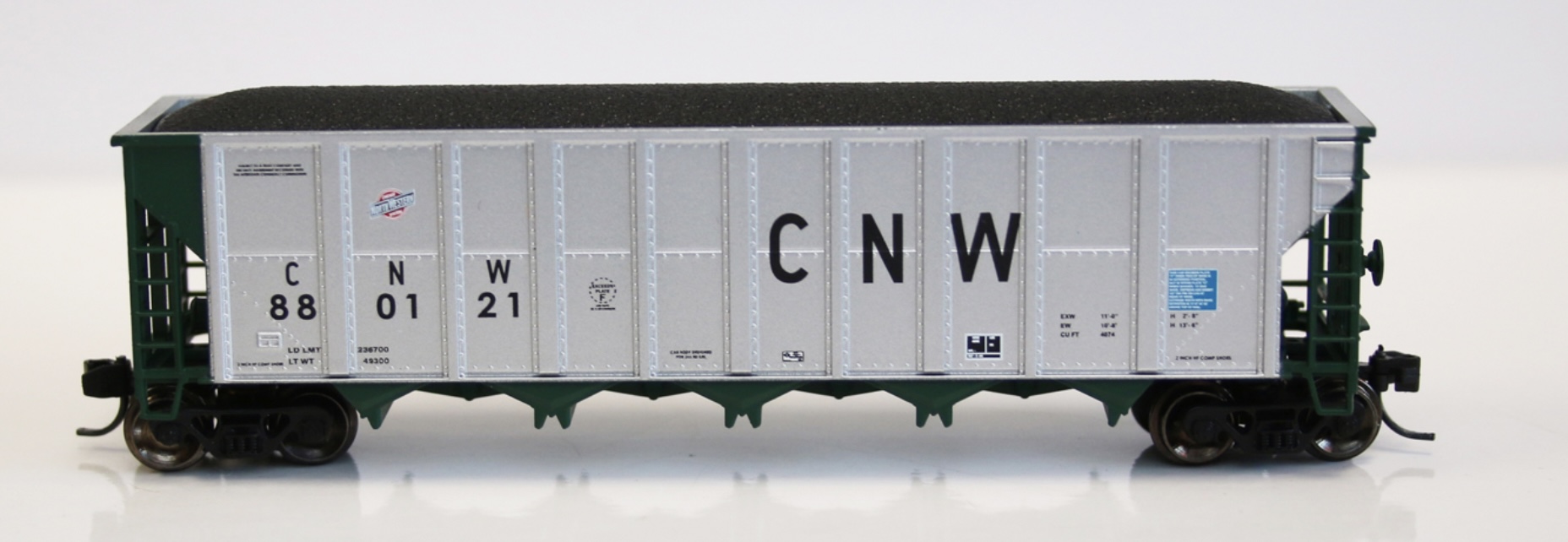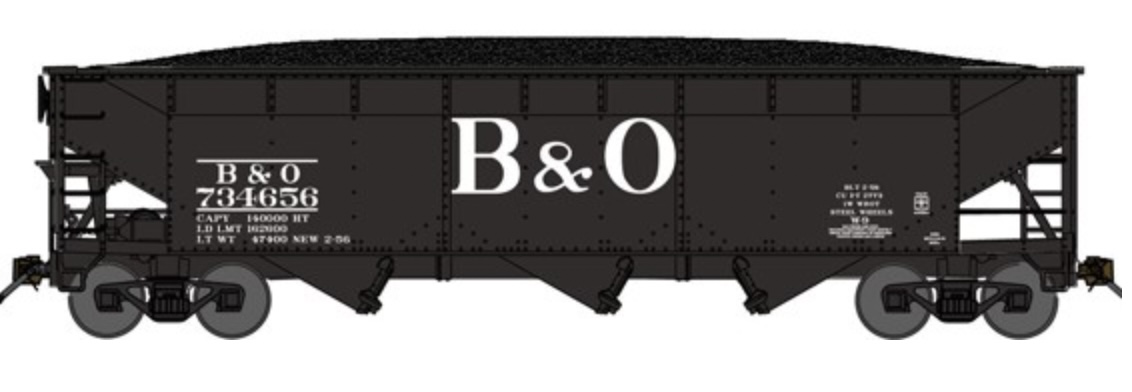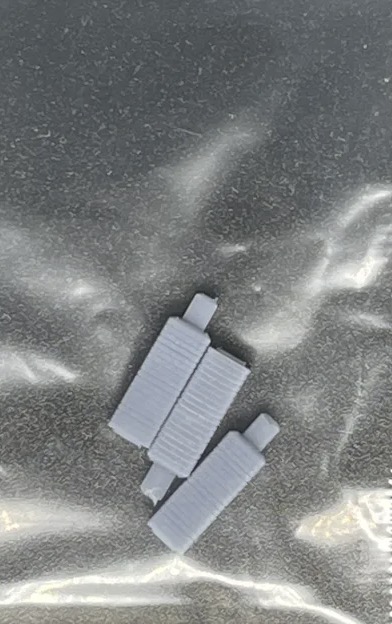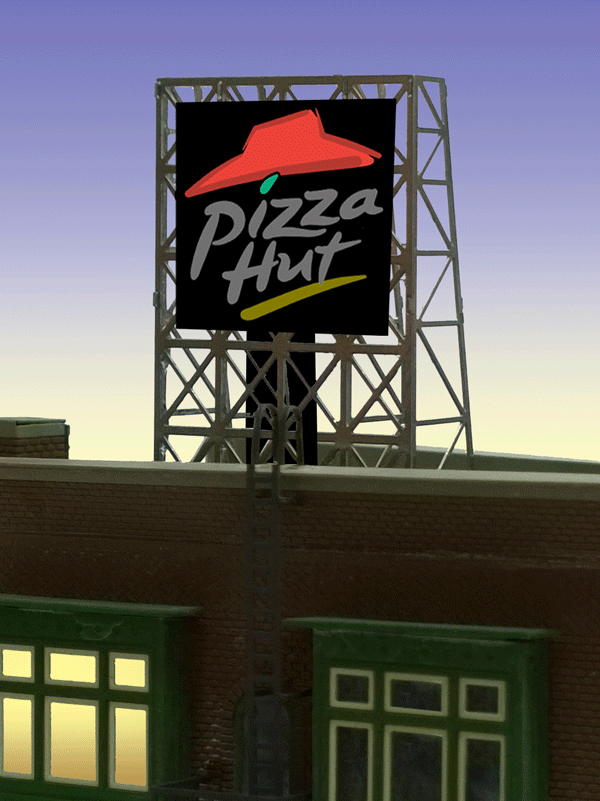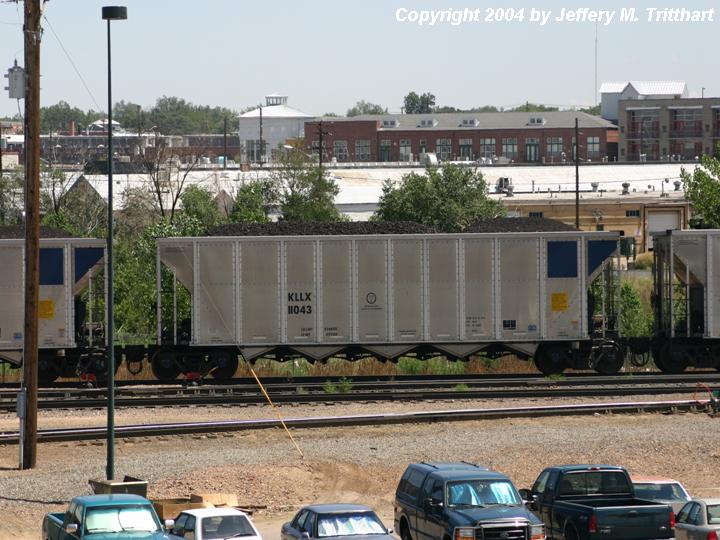Model Information: This Fox Valley model was actually designed by Fox Valley and not acquired from another vendor such as their 5-Bay Ortner model. It is an excellent model; it has good detail and excellent printing. The body mount couplers and high quality chemically blackened low-profile wheels are both nice features. Also, as expected, they have the world-class Fox Valley blackened metal wheels, known to have accurate proportions as well as running smoothly and relatively quietly.
The one thing they got wrong is the cheesy load. It looks like they studied the loads from the Red Caboose/Precision Masters models that they acquired and decided "well if modelers will settle for that, I guess we don't need to work very hard to make something better". And that is what they got - something that is not better, but should be. Fortunately with a little patience you can remove the factory loads and put your own in. They are not glued in.
The one thing they got wrong is the cheesy load. It looks like they studied the loads from the Red Caboose/Precision Masters models that they acquired and decided "well if modelers will settle for that, I guess we don't need to work very hard to make something better". And that is what they got - something that is not better, but should be. Fortunately with a little patience you can remove the factory loads and put your own in. They are not glued in.
Prototype History: The 1960s brought about a growth in car size (and capacity). Railroads that transported coal moved away from the older 2-bay 55-ton USRA standard to newer railcars. The Trinity RD IV (or RD-4) has a 4200 cubic foot capacity and is principally used for coal. They are 53 foot 1inches long. And have been used by power plants as well as commercial railroads. The cars are recognizable from their alternating six-thin-and-five-thick exterior post pattern. Information about this railcar can be found in the Simmons-Boardman 1997 Car & Locomotive Cyclopedia.
Road Name History: The Chicago and North Western Transportation Company (reporting mark CNW) was a Class I railroad in the Midwestern United States. It was also known as the North Western. The railroad operated more than 5,000 miles (8,000 km) of track as of the turn of the 20th century, and over 12,000 miles (19,000 km) of track in seven states before retrenchment in the late 1970s.
Until 1972, when the company was sold to its employees, it was named the Chicago and North Western Railway. The C&NW became one of the longest railroads in the United States as a result of mergers with other railroads, such as the Chicago Great Western Railway, Minneapolis and St. Louis Railway and others.
By 1995, track sales and abandonment had reduced the total mileage back to about 5,000. The majority of the abandoned and sold lines were lightly trafficked branches in Iowa, Illinois, Minnesota, South Dakota and Wisconsin. Large line sales, such as those that resulted in the Dakota, Minnesota and Eastern Railroad further helped reduce the railroad to a mainline core with several regional feeders and branches.
The company was purchased by Union Pacific Railroad (UP) in April 1995 and ceased to exist.
Until 1972, when the company was sold to its employees, it was named the Chicago and North Western Railway. The C&NW became one of the longest railroads in the United States as a result of mergers with other railroads, such as the Chicago Great Western Railway, Minneapolis and St. Louis Railway and others.
By 1995, track sales and abandonment had reduced the total mileage back to about 5,000. The majority of the abandoned and sold lines were lightly trafficked branches in Iowa, Illinois, Minnesota, South Dakota and Wisconsin. Large line sales, such as those that resulted in the Dakota, Minnesota and Eastern Railroad further helped reduce the railroad to a mainline core with several regional feeders and branches.
The company was purchased by Union Pacific Railroad (UP) in April 1995 and ceased to exist.
Brand/Importer Information: Fox Valley Models is a small supplier of
model railroad and related products. FVM
started by finding solutions to different
challenges that model railroaders were
faced with. Our first products resulted
from a need to equip custom built
passenger cars with tinted windows made
of an ideal material; thin, flexible, easy to
cut, simple to install, available in multiple
colors and be affordable. We met those
needs and even included a frosted
version for the car's lavatory windows.
Other challenges inspired additional products including wooden grade crossings, trestles and different lineside structures. As our product line expands, input and requests from friends and customers help shape the product selection further.
Future products, under development, include more parts, structures, details and rolling stock. We strive to offer a good quality product at an affordable price.
Other challenges inspired additional products including wooden grade crossings, trestles and different lineside structures. As our product line expands, input and requests from friends and customers help shape the product selection further.
Future products, under development, include more parts, structures, details and rolling stock. We strive to offer a good quality product at an affordable price.
Item created by: CNW400 on 2022-07-02 08:57:52. Last edited by CNW400 on 2022-07-02 08:57:53
If you see errors or missing data in this entry, please feel free to log in and edit it. Anyone with a Gmail account can log in instantly.
If you see errors or missing data in this entry, please feel free to log in and edit it. Anyone with a Gmail account can log in instantly.


